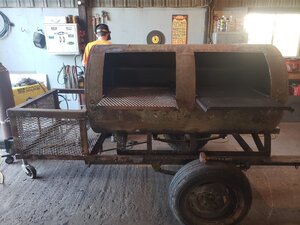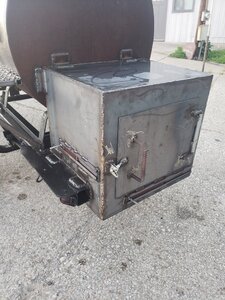Is that formula only for a certain type of smoker such as a charcoal one? What about Electric and propane smokers?
Science behind smokestack size?
- Thread starter fourthwind
- Start date
-
Some of the links on this forum allow SMF, at no cost to you, to earn a small commission when you click through and make a purchase. Let me know if you have any questions about this.
You are using an out of date browser. It may not display this or other websites correctly.
You should upgrade or use an alternative browser.
You should upgrade or use an alternative browser.
SmokingMeatForums.com is reader supported and as an Amazon Associate, we may earn commissions from qualifying purchases.
ccjammer
Newbie
- Jul 23, 2014
- 1
- 10
ccjammer here,i have a 20 inch x 48 inch long cooker with a 18 x 20 square fire box offset
it has a 3 inch dia. x 30 inch long stack on the side top and was wanting to replace with a 4
inch dia. that is 4 foot long,is that sufficient enough or do I place it towards center of pit,any
.answers will be very appreciated.
it has a 3 inch dia. x 30 inch long stack on the side top and was wanting to replace with a 4
inch dia. that is 4 foot long,is that sufficient enough or do I place it towards center of pit,any
.answers will be very appreciated.
pootin pig
Newbie
- Jan 13, 2016
- 1
- 10
Trying to determine exhaust stack size. I'm wanting to do dual stacks. I've taken an old pig cooker that is 60" longX30" deep, and 30" high. I built a firebox that is 24x24x30 with an opening that is 30x 51/4. The firebox is mounted on the lower back of the cooker and I have a plate inside of the cooking chamber to spread out the heat. I want to do dual stacks on the top at the rear corners. the only calculators I found give you single stack only. I'm thinking like 2- 3" stacks around 32" tall should do it. What do you think???????? Would that be the same as 1- 6' stack?
No... not the same.... actually exactly half the size needed.... 4 - 3" stacks would be the same... I would go with 2 - 5" stacks...
bitterroot mt
Newbie
- Mar 30, 2010
- 1
- 10
I know this is a old thread but based on the 15%
and 1/3 theory
if my tank is 92 Long
it is 38 wide
My stack should be 6in wide and 31 Tall.
I am building a firebox from 2 55 gallon drums w with doors at either end like drum stoves.
23 wide 70 long
I realize it is a little undersized .... all I could scrape up.
.
2 6 inch inlets between the firebox and cook chamber .
Set up like a diamond plate Pit Mod.
Anyway.. Could I use two 3 inch or 4 inch stacks with dampers.on this and mabey a little shorter say 24-26 inches tall
and be ok ..
MY thought is that it would hold in heat longer and still let out the correct volume.... am I correct here?
Thanks
and 1/3 theory
if my tank is 92 Long
it is 38 wide
My stack should be 6in wide and 31 Tall.
I am building a firebox from 2 55 gallon drums w with doors at either end like drum stoves.
23 wide 70 long
I realize it is a little undersized .... all I could scrape up.
.
2 6 inch inlets between the firebox and cook chamber .
Set up like a diamond plate Pit Mod.
Anyway.. Could I use two 3 inch or 4 inch stacks with dampers.on this and mabey a little shorter say 24-26 inches tall
and be ok ..
MY thought is that it would hold in heat longer and still let out the correct volume.... am I correct here?
Thanks
Are you using this tutorial for your build ???
http://www.smokingmeatforums.com/a/reverse-flow-smoker-how-to-calculate-build-tutorial
http://www.smokingmeatforums.com/a/reverse-flow-smoker-how-to-calculate-build-tutorial
dave schiller
Meat Mopper
I used to heat my house with a wood burning stove and from all I read and learned, the draft effect of the chimney is caused by heated air being less dense (lighter) than cold air. The heated air in the flue therefore rises, inducing (pulling) cooler air into and through the heating chamber. Since the heated air rising up the flue is gradually cooled by contact with the flue, I guess it's possible that if the flue is too long, the heated air will drop to the temperature of the ambient air, thus eliminating the draft effect.
Conversely, if a fan is used to force air into the heating chamber, as with a BBQGuru or similar system, then it wouldn't matter if the flue gas is too cool to induce draft through the system.
My guess is that the optimum length for a chimney on a smoker will vary with the ambient air temperature. That is, during hot summer days, longer flues can be used. But on very cold winter days, a long flue may result in too much cooling and reduce or eliminate the draft effect.
Conversely, if a fan is used to force air into the heating chamber, as with a BBQGuru or similar system, then it wouldn't matter if the flue gas is too cool to induce draft through the system.
My guess is that the optimum length for a chimney on a smoker will vary with the ambient air temperature. That is, during hot summer days, longer flues can be used. But on very cold winter days, a long flue may result in too much cooling and reduce or eliminate the draft effect.
anstissk
Smoke Blower
OK..... so I ran the numbers for a 48" x 20" CC and my calculator comes up with a 20" tall stack X 4" diameter...... I would make it 30" tall just because.... Pretty much what your 16" tall x 4" diameter...... Your engineers probably copied us.... HAHAHAHAHA...... our members make some darn good smokers....
Dave, so just because I am curious...I have seen on a few builds where the OP did the calculations in the tutorial and you mention that you would make the stack longer. In this example, you mentioned you would make it 10" longer just because....
Is there something driving that decision, do you like taller stacks in general? Just curious
Natural draft requires volume in a stack to reduce friction and pressure differential to facilitate draft... Pressure differential can be from height of stack and temperature differential of gasses in the stack and ambient temperature.......
anstissk
Smoke Blower
Makes sense. So typically just adding some additional length as it most certainly will not hurt anything.Natural draft requires volume in a stack to reduce friction and pressure differential to facilitate draft... Pressure differential can be from height of stack and temperature differential of gasses in the stack and ambient temperature.......
offset1945
Newbie
- Aug 5, 2016
- 28
- 18
This topic keeps going and going .....
In the real world this is Flu Stack Science and you can have a job where this is what you'd care about.
I know people, myself included have looked for the hard science here and I can tell you that you will not exactly find your answer in the BBQ world, it is all about opinion and 'feel'.
I can say that the calculator I 'feel' is spot on with its CC to FB ratios and that as Dave suggests needs to allow for slightly more volume on the stack calculation.
Now I am talking 'volume' .... so if Dave is suggesting 10" more for a 4" inner diameter stack, I feel that is spot on and I am in full agreement.
The calculator is doing this for an FB that is 20" wide and 24" long ( a VERY popular size) based on one saying they have a 4" stack diameter:
Volume = πr2h= π×22×30= 120π= 376.99111843078 inches3
It is saying your stack "volume" should be 376 cubic inches and therefore the stack should be 30" long based on opting for a 4" stack diameter.
The number to care about there is the 30 ... that is what the calculator solved for ....
The 376 cubic inches comes from the notion of 5% of the firebox volume should be the stack volume.
The calculator takes what it feels is the correct stack volume and then based on your input for stack diameter give you the length of the stack.
Google 'Volume of a Cylinder' and you will find plenty of calculators.
What Dave and I are saying from this calculator perspective is that the % of firebox volume used to derive stack volume should be higher ... or perhaps not based on FB volume, but that is getting sideways.
So to say it again, it is all about volume and if Dave suggests adding about 10" and if he is taking about a 4" diameter stack I fully agree.
(.i.e. you would not add 10" if your stack diameter is 6")
Cheers to all!
In the real world this is Flu Stack Science and you can have a job where this is what you'd care about.
I know people, myself included have looked for the hard science here and I can tell you that you will not exactly find your answer in the BBQ world, it is all about opinion and 'feel'.
I can say that the calculator I 'feel' is spot on with its CC to FB ratios and that as Dave suggests needs to allow for slightly more volume on the stack calculation.
Now I am talking 'volume' .... so if Dave is suggesting 10" more for a 4" inner diameter stack, I feel that is spot on and I am in full agreement.
The calculator is doing this for an FB that is 20" wide and 24" long ( a VERY popular size) based on one saying they have a 4" stack diameter:
Volume = πr2h= π×22×30= 120π= 376.99111843078 inches3
It is saying your stack "volume" should be 376 cubic inches and therefore the stack should be 30" long based on opting for a 4" stack diameter.
The number to care about there is the 30 ... that is what the calculator solved for ....
The 376 cubic inches comes from the notion of 5% of the firebox volume should be the stack volume.
The calculator takes what it feels is the correct stack volume and then based on your input for stack diameter give you the length of the stack.
Google 'Volume of a Cylinder' and you will find plenty of calculators.
What Dave and I are saying from this calculator perspective is that the % of firebox volume used to derive stack volume should be higher ... or perhaps not based on FB volume, but that is getting sideways.
So to say it again, it is all about volume and if Dave suggests adding about 10" and if he is taking about a 4" diameter stack I fully agree.
(.i.e. you would not add 10" if your stack diameter is 6")
Cheers to all!
MikeFromTexas
Newbie
- Jan 11, 2020
- 7
- 5
Considering the air just outside the inlet of the firebox and the air right at the top of the smoke stack and energy balance can be made. An energy balance between these to points takes into account all forms of energy losses & additions between these two points. Energy losses can be broken down into what’s called minor losses and major losses. Minor losses are things like sudden contractions (like between the firebox & cooking chamber; also from cooking chamber to exhaust pipe), bends (like the 180 deg turn of a reverse flow), sudden expansions (end of exhaust pipe). Minor losses are directly proportional to the square of the velocity locally where the loss is occurring. Major losses are those associated with friction. Friction derives from the viscosity of the air and is directly proportional to the square of the velocity and also the length-to-diameter ratio. The flow in a smoker is what’s called buoyancy driven flow or also known as natural flows. These flows are driven by a temperature difference. The air right outside the firebox is cool and has high density. The fire in the firebox heats the air inside the firebox. As air temperature increases, the density decreases. In the presence of gravity, the lower density will rise. As the lower density air rises, the cooler air from outside the firebox is moves in to fill the space of the air that has moved from the firebox into the cooking chamber. So all the magic of a smoker is really about achieving the proper flow rate of air which is influenced by the above listed factors. The energy losses hinder the amount of flow.
The use of a damper is really an obstruction to the flow and as such is a minor loss used to control the flow rate. This limits the amount of air that can then enter the firebox. The exhaust pipe diameter to length ratio is most important, not diameter or length alone. The friction energy loss developed by the exhaust pipe walls is not adjustable.
The use of a damper is really an obstruction to the flow and as such is a minor loss used to control the flow rate. This limits the amount of air that can then enter the firebox. The exhaust pipe diameter to length ratio is most important, not diameter or length alone. The friction energy loss developed by the exhaust pipe walls is not adjustable.
I am making a smoker out tank that is 5ft long and 33" wide barrel. My firebox is mounted on one end. The heat is coming into barrel 7" from bottom. The firebox is 26"W x 20"L x 24"H. My question is my stack is at the other end of smoker so what size and long does it to be? And how high so it need to be?Natural draft requires volume in a stack to reduce friction and pressure differential to facilitate draft... Pressure differential can be from height of stack and temperature differential of gasses in the stack and ambient temperature.......
Picture please.. Maybe a 6" stack 40" above the CC...
Firebox is not used in the calculation... Only the CC volume....
Firebox is not used in the calculation... Only the CC volume....
Picture please.. Maybe a 6" stack 40" above the CC...
Firebox is not used in the calculation... Only the CC volume....
Attachments
I'm trying to figure out the size of the opening between the FB and CC... Ususlly it's a 1/2 moon shape following the curve of the CC.. and to the top of the FB.....
Read this tutorial... It will help explain stuff...
 www.smokingmeatforums.com
www.smokingmeatforums.com




Read this tutorial... It will help explain stuff...
Standard Reverse Flow Smoker Calculator... by DaveOmak and others... Ready to use.. rev5.. 6/19/15.
Here's to "Alien BBQ" and the folks that first put the calculator together and "1728 Software Systems" for this great "Circle Calculator" and all the folks at "SmokingMeatForums", with a special shout out to Ribwizzard, that contributed their ideas and feedback while this thing was coming...

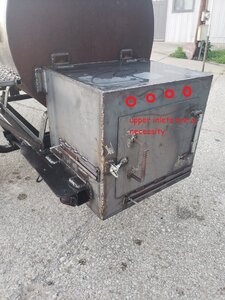
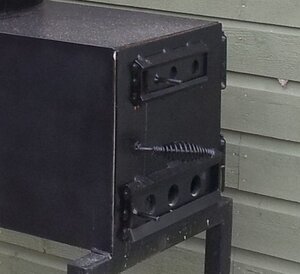
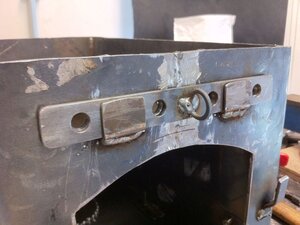
I was wanting to build a offset smoke not a reverse flowI'm trying to figure out the size of the opening between the FB and CC... Ususlly it's a 1/2 moon shape following the curve of the CC.. and to the top of the FB.....
Read this tutorial... It will help explain stuff...
Standard Reverse Flow Smoker Calculator... by DaveOmak and others... Ready to use.. rev5.. 6/19/15.
Here's to "Alien BBQ" and the folks that first put the calculator together and "1728 Software Systems" for this great "Circle Calculator" and all the folks at "SmokingMeatForums", with a special shout out to Ribwizzard, that contributed their ideas and feedback while this thing was coming...www.smokingmeatforums.com
View attachment 446364
View attachment 446361View attachment 446363
View attachment 446362
You still need air flow ?????
The numbers in the tutorial work perfect for either type of smoker....
The numbers in the tutorial work perfect for either type of smoker....
SmokingMeatForums.com is reader supported and as an Amazon Associate, we may earn commissions from qualifying purchases.
Similar threads
- Replies
- 6
- Views
- 8K
- Replies
- 21
- Views
- 2K
- Replies
- 6
- Views
- 3K
Hot Threads
-
Dehydrater
- Started by pc farmer
- Replies: 31
- Blowing Smoke Around the Smoker.
-
Pop’s brine scalable?
- Started by curmudgeonly
- Replies: 22
- Info and Practices
-
Just a Simple Breakfast
- Started by BrianGSDTexoma
- Replies: 19
- Breakfast
-
Friday Cocktail Hour. Whatchya Drinkin'?
- Started by Quiganomics
- Replies: 18
- General Discussion


